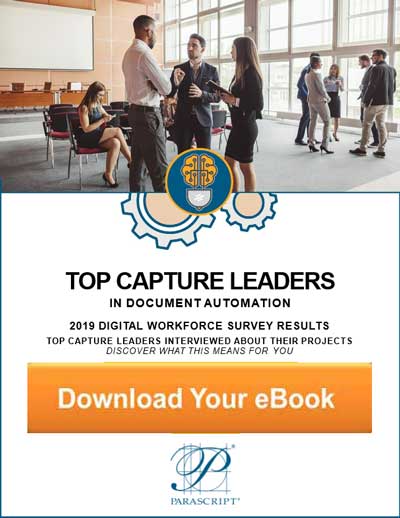Today, accelerating process automation means implementing workflows that no longer require staff to manually sort documents and enter data, often called “unattended automation”. The digital workforce is all about removing as much unnecessary manual labor as possible to enable straight-through processing capabilities. Advanced capture facilitates increased digital dexterity for front, middle and back office employees by giving access to relevant data at key points in automated document processes.
The traditional idea of “capture” or the ability of scanners and software to convert printed information into digital data is one that we are all familiar with in terms of scanning paper documents to create digital versions instead. This fundamental scan-and-store approach reduces the costs and inefficiencies of paper-intensive processes.
Accelerating process automation means implementing workflows that no longer require staff to manually sort documents and enter data, a.k.a. “unattended automation.”
Modern advanced capture-enabled automation includes all kinds of document processing capabilities from classification of photos and video, extraction of key concepts in email and voicemail, to locating and extracting key data in all nature of business files and documents using a variety of systems and formats. The aim is to capture and manage all business information regardless of where it comes from or how it is presented. The ability to capture information at any point in any process is a big boost to information management. This lowers costs, reduces risk and increases organizational performance.
Capturing Opportunity & the Virtual Data Assistant
It is not just about paper. It is about more accurately and rapidly capturing and using information in agile and dynamic ways with capture technology serving not simply as the bridge between paper and digital media, but as the virtual data assistant at each critical point in RPA for staff to access the most relevant and up-to-date information from their business systems. This new view of capture is quickly being adopted as a result. In a new study conducted by AIIM International, 70% of responding companies say they anticipate expanding document processing automation to more digitally-born documents over the next three years.
The New Capture Paradigm
As the volume and variety of enterprise information continues to grow, so does the need for well-thought strategies and approaches for intelligent information management. While organizations have traditionally focused on things like cost, risk and compliance, a more expansive approach is taking hold that has broader implications in terms of organizational performance.
Organizations are no longer limiting their information governance view to “collect and protect.” They now include the value of information as a driver for increased revenue, predictive analytics and development of new products and markets. This new paradigm requires that organizations have the ability to understand what information they have throughout the enterprise, more completely find, share and analyze that information, and then take action more quickly to capitalize on emerging opportunities in the market or to better perform against the competition.
Capturing More Value
One defining success factor for organizations today is the ability to capture, categorize and understand information, in whatever form it takes, and then use that information to inspire process improvement, boost customer service, and fuel more agile and informed business intelligence. Organizations can capture more value out of information, often with the systems they already own, by adopting a broader view of capture that looks beyond a typical front end, scan-and-store approach. The key to capturing value is the adoption of comprehensive tools and strategies to automate and broaden the application of capture enterprise-wide. The key to successful implementation is starting with smaller projects to find out what works and what doesn’t, and then going large. Here you can leverage technologies to extend your data ecosystem and manage your content 24/7 everywhere work is performed.
# # #
Kevin Craine is the author of the book Designing a Document Strategy and host of the Document Strategy Podcast. He is the managing director of Craine Communications Group. For more information visit CraineGroup.com.
If you found this article interesting, you may find this ebook useful. It provides the results of the most recent AIIM survey of 100 top capture leaders focused on document automation.


